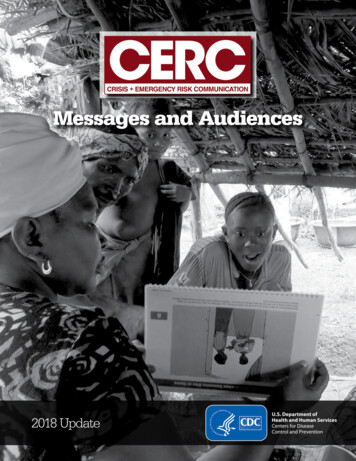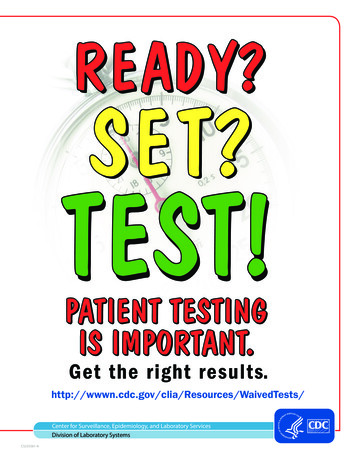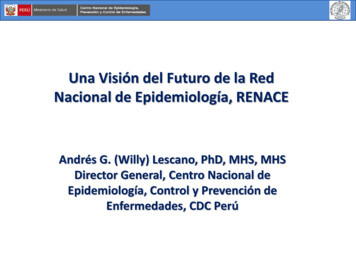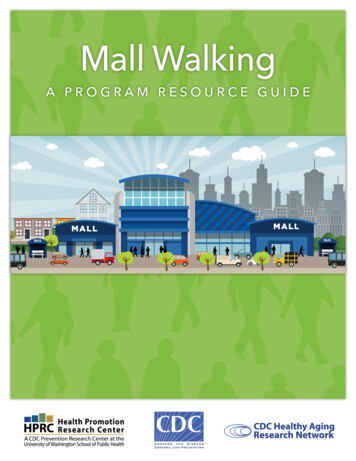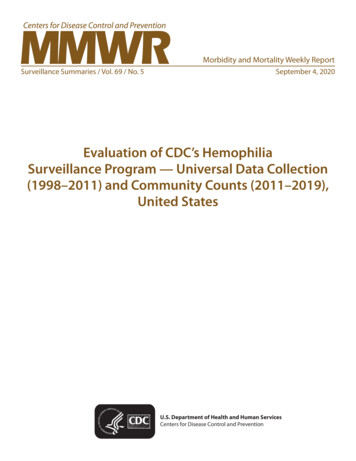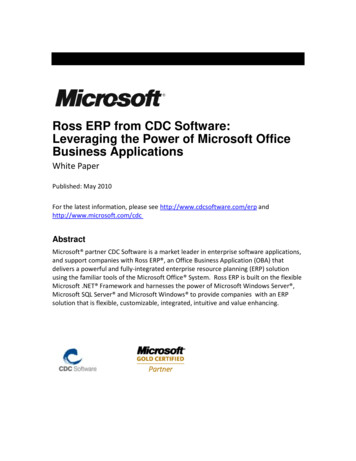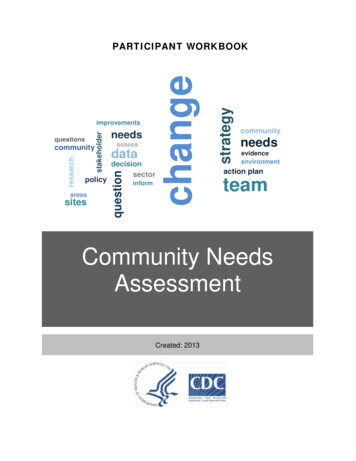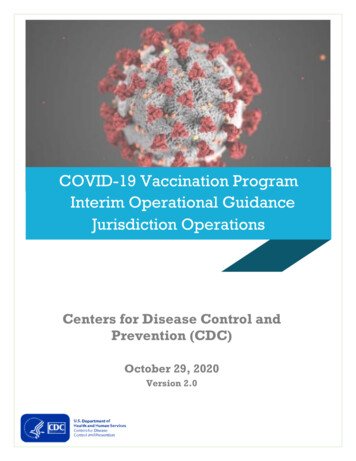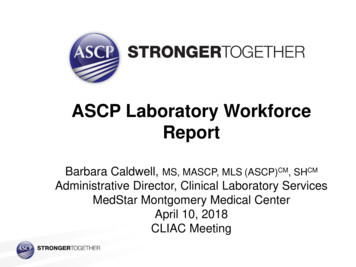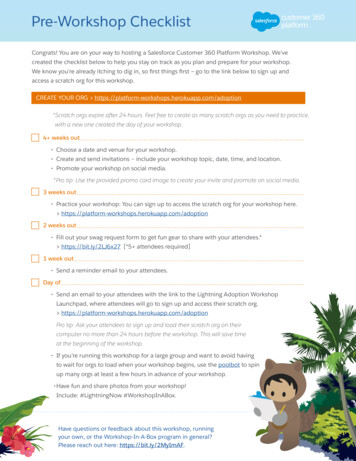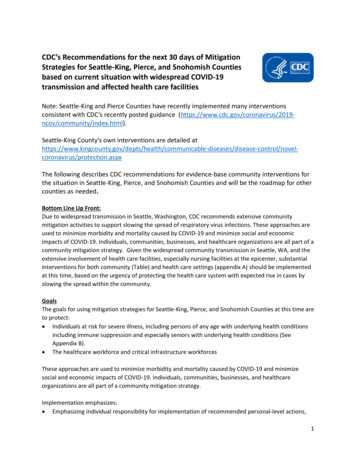
Transcription
CDC’s Recommendations for the next 30 days of MitigationStrategies for Seattle-King, Pierce, and Snohomish Countiesbased on current situation with widespread COVID-19transmission and affected health care facilitiesNote: Seattle-King and Pierce Counties have recently implemented many interventionsconsistent with CDC’s recently posted guidance y/index.html).Seattle-King County’s own interventions are detailed tection.aspxThe following describes CDC recommendations for evidence-base community interventions forthe situation in Seattle-King, Pierce, and Snohomish Counties and will be the roadmap for othercounties as needed.Bottom Line Up Front:Due to widespread transmission in Seattle, Washington, CDC recommends extensive communitymitigation activities to support slowing the spread of respiratory virus infections. These approaches areused to minimize morbidity and mortality caused by COVID-19 and minimize social and economicimpacts of COVID-19. Individuals, communities, businesses, and healthcare organizations are all part of acommunity mitigation strategy. Given the widespread community transmission in Seattle, WA, and theextensive involvement of health care facilities, especially nursing facilities at the epicenter, substantialinterventions for both community (Table) and health care settings (appendix A) should be implementedat this time, based on the urgency of protecting the health care system with expected rise in cases byslowing the spread within the community.GoalsThe goals for using mitigation strategies for Seattle-King, Pierce, and Snohomish Counties at this time areto protect: Individuals at risk for severe illness, including persons of any age with underlying health conditionsincluding immune suppression and especially seniors with underlying health conditions (SeeAppendix B). The healthcare workforce and critical infrastructure workforcesThese approaches are used to minimize morbidity and mortality caused by COVID-19 and minimizesocial and economic impacts of COVID-19. Individuals, communities, businesses, and healthcareorganizations are all part of a community mitigation strategy.Implementation emphasizes: Emphasizing individual responsibility for implementation of recommended personal-level actions,1
Empowering businesses, schools, and community organizations to implement recommended actions,particularly in ways that protect persons at risk of severe illness such as older adults and persons withserious underlying health conditions (e.g., people requiring dialysis, or those with congestive heartfailure or emphysema)Focusing on settings that provide critical services to implement recommended actions to protectcritical infrastructure and individuals at risk of severe diseaseMinimizing disruptions to daily life to the extent possibleTable Community mitigation strategies for Seattle-King, Pierce, and Snohomish CountiesCommunityEvery Individual andFamily at HomeMitigation Strategies Every School/childcare Every assisted livingfacility, Senior livingfacility and adult dayprogram Monitor local information about COVID-19 in your community.Practice personal protective measures (e.g. hand washing).Put household plan into actionEnsure 30 day supply of all medicines.Individuals at risk of severe illness should stay at home avoiding gatherings or other situationsof potential exposures, including travel, church attendance, social events with 10 or morepeopleOther individuals without such risk factors should adapt to disruptions in routine activities(e.g., school and/or work closures) by using remote participation such as telework wherefeasible or online classes or home study (E-learning).Schools should arrange for students at risk of severe illness to be able to implement individualplans for distance learning, e-learning.Implement social distancing measures, e.g.:o Cancel large gatherings (e.g., assemblies)o Postpone athletic contests (basketball, football games) in the absence of spectatorso Limit all classroom mixingo Alter schedules to reduce mixing (e.g., stagger recess, entry/dismissal times)o Limit inter-school interactions of all typeso Consider distance or e-learning in schools with higher risk populations (.e.g, greaterproportion of special needs children)Regular health checks (e.g., temperature and respiratory symptom screening on arrival atschool) of students, staff, and visitors.Short-term dismissals for school and extracurricular activities as needed (e.g., if cases instaff/students) for cleaning and contact tracingExtend spring break by an additional two weeks to be made up at the end of the standardterm.Cancellation of all school-associated congregations, particularly those with participation ofhigh-risk individuals.Consider implementing distance learning if feasibleImplement social distancing measures, e.g.:o Cancel large gatherings (e.g., group social events with 10 or more people)o Alter schedules to reduce mixing (e.g., stagger meal, activity, arrival/departure times)o Limit programs with external staffDaily upon arrival temperature and respiratory symptom screening of attendees, staff.Staff should wear masks and wash hands thoroughly before entering and after exit of room ofinhabitants2
Every Workplace Every Community andFaith-basedOrganization Consider suspension of new admissions to facilitiesShort-term closures as needed (e.g., if cases in staff, residents or clients who live elsewhere)for cleaning and contact tracingLonger-term closure or quarantine of facility until situation resolves.Suspend visitor access but arrange for alternate means for family members to communicate(e.g., staff assist with phone calls or videoconferences with visitors).Exceptions for end-of-life family visits need to be considered, with limited access of visitors toother areas or people in the facility and these patients should be in a different areas to ensureother clients are not exposed to outside guests.Encourage staff to teleworkExpand sick leave policiesImplement social distancing measures, e.g.:o Spacing workers at the worksiteo Staggering work scheduleso Decreasing social contacts in the workplace (limit in-person meetings)o All break areas must accommodate distancing with regular disinfection of all eatingsurfacesEliminate large work-related gatherings (e.g., staff meetings, after-work functions)Postpone non-essential work travelRegular health checks on arrival each day (e.g., temperature and respiratory symptomscreening) of staff and visitors entering buildings.Implement extended telework arrangements (when feasible)Ensure flexible leave policies for staff who need to stay home due to school/childcaredismissals and to encourage individuals to stay home if they are sick.Cancel work-sponsored conferences, tradeshows, etc.Implement social distancing. Reduce activities (e.g., religious services, group congregation),especially for organizations with individuals at risk of severe illness. Consider offeringvideo/audio of events.Determine methods to continue providing support services to individuals at risk of severedisease (services, meals, checking in) while limiting group settings and exposuresCancel large gatherings (e.g., 250 people) or move to smaller groupings.Professional and college sporting events as well as concerts or any large crowd entertainmentevents should be cancelled or broadcast without audience participation.For organizations that serve high-risk communities, cancel gatherings of more than 10 peopleand stagger access to support services.Move faith-based and community gatherings of any size to video-accessible venues orpostpone/cancel.3
Healthcare settingsand healthcareprovider (includesoutpatient, nursinghomes/long-term carefacilities, inpatient,telehealth) ** Institute temperature/symptom checks for staff, visitors, limit visitor movement in the facilityImplement triage before entering facilities (e.g. parking lot triage, front door); phone triageand telemedicine; limit unnecessary healthcare visitsActively monitor HCP absenteeism and respiratory illness among HCP and patientsActively monitor PPE suppliesEstablish processes to evaluate and test large numbers of patients and HCP with respiratorysymptoms (e.g., designated clinics for people with fever, surge tent for overflow triage, offsitetesting locations)Permit asymptomatic exposed HCP to work while wearing a facemaskCross train HCP for working in other units to support staffing shortagesRestrict all visitors from facility entry to reduce facility-based transmission; exceptions for endof-life visitors but restrict such visitors’ movements within the facility.Identify areas of operations that may be subject to alternative standards of care andimplement necessary changes (e.g., allowing mildly symptomatic HCP to work while wearing afacemask)Cancel elective and non-urgent proceduresEstablish cohort units or facilities for large numbers of patientsConsider requiring all HCP to wear a facemask when in the facility depending on supplyConsider suspension of new admissions to facilities** Appendix with more detail for long term care facilitiesAppendix A: CDC Recommendations for Seattle-King, Pierce, and Snohomish Counties, WA Strategyfor Long-term Care FacilitiesBackground:Given their congregate nature and resident population served (e.g., older adults with multiple comorbidities), all long-term care facilities are at the highest risk of being affected by COVID-19. Ifinfected, residents are at highest risk for morbidity and mortality and, based on early experience, havethe potential to decompensate quickly.Ill healthcare personnel (HCP) or visitors are the most likely sources of introduction of COVID-19 into thefacility. To protect this fragile population, aggressive efforts toward visitor restrictions and screening ofHCP for fever and respiratory symptoms when they report to work are recommended, even beforeCOVID-19 is identified in a community or facility.Objectives: Protect healthcare personnel (HCP) to maintain a functioning healthcare systemMinimize morbidity and mortalityMinimize transmissionPlan:4
Testing: Establish central location and process for referring ill HCP for COVID-19 testingTraining: Perform remote regional infection prevention and control trainings for long-term carepersonnel. Emphasis on:o HCP monitoringo Selection and use of recommended PPE Use of Standard, Contact, and Droplet Precautions with eye protection for anyundiagnosed respiratory infection for which airborne precautions is nototherwise recommended (e.g., tuberculosis)o Visitor restrictionso Active checks for fever and respiratory symptom for patients, residents, and HCPo Restrictions on resident movement and activitiesVisitor Restrictions: Restrict all visitation to long-term care facilities and other congregatehealthcare settingso Exceptions might be allowed for end-of-life situations. In this situation, the visitorshould wear a facemask and eye protection and be restricted to the resident’s room.HCP Monitoring and Restrictions:o Restrict non-essential personnel including volunteers and non-essential consultantpersonnel (e.g., barbers) from entering the buildingo Screen all HCP at the beginning of their shift for fever and respiratory symptoms Actively take their temperature and document absence of shortness of breath,new or change in cough, and sore throat. If they are ill, have them put on afacemask and self-isolate at home Ill HCP should be prioritized for testing HCP who work in multiple locations may pose higher risk and should bemonitored for exposure to facilities with recognized COVID-19 caseso Implement universal facemask use for HCP while in the facilityo Consider having HCP wear all recommended PPE (gown, gloves, eye protection,facemask) for the care of all residents, regardless of presence of symptomsResident Monitoring and Restrictions:o Actively monitor all residents (at least daily) for fever and respiratory symptoms(shortness of breath, new or change in cough, and sore throat). If positive for fever or symptoms, implement recommended IPC practiceso Restrict residents to their room (except for medically necessary purposes) If they leave their room they should wear a facemask, perform hand hygiene,limit their movement in the facility, and perform social distancing (stay at least 6feet away from others)o Cancel group field trips and activities, including communal diningo Have a low threshold to transfer residents with fever or acute respiratory illness to ahigher level of careManaging PPE Shortages: When PPE supplies are limited, rapidly transition to extended use ofeye and face protection (i.e., respirators or facemasks) – e.g., changing facemask every 2 hourswhile at work unless wet or soiled.Reporting to the Health Department: Notify the health department about anyone with COVID19 or if facility identifies 2 or more residents or HCP with respiratory infection within 72 hours.5
Appendix B: Underlying medical conditions that may increase the risk of serious COVID-19 forindividuals of any age. Blood disorders (e.g., sickle cell disease or on blood thinners) Chronic kidney disease as defined by your doctor. Patient has been toldto avoid or reduce the dose of medications because kidney disease, or isunder treatment for kidney disease, including receiving dialysis Chronic liver disease as defined by your doctor. (e.g., cirrhosis, chronichepatitis) Patient has been told to avoid or reduce the dose ofmedications because liver disease or is under treatment for liverdisease. Compromised immune system (immunosuppression) (e.g., seeing adoctor for cancer and treatment such as chemotherapy or radiation,received an organ or bone marrow transplant, taking high doses ofcorticosteroids or other immunosuppressant medications, HIV or AIDS) Current or recent pregnancy in the last two weeks Endocrine disorders (e.g., diabetes mellitus) Metabolic disorders (such as inherited metabolic disorders andmitochondrial disorders) Heart disease (such as congenital heart disease, congestive heart failureand coronary artery disease) Lung disease including asthma or chronic obstructive pulmonarydisease (chronic bronchitis or emphysema) or other chronic conditionsassociated with impaired lung function or that require home oxygen Neurological and neurologic and neurodevelopmentconditions [including disorders of the brain, spinal cord, peripheralnerve, and muscle such as cerebral palsy, epilepsy (seizure disorders),stroke, intellectual disability, moderate to severe developmental delay,muscular dystrophy, or spinal cord injury].6
Consider implementing distance learning if feasible Every assisted living facility, Senior living facility and adult day program Implement social distancing measures, e.g.: o Cancel large gatherings (e.g., group social events with 10 or more people) o Alter schedules to reduce mixin

